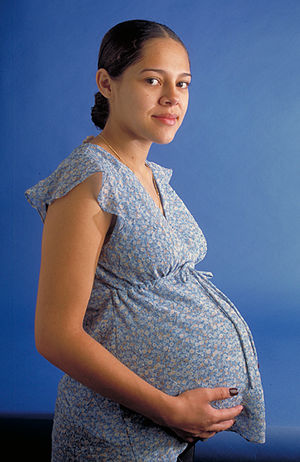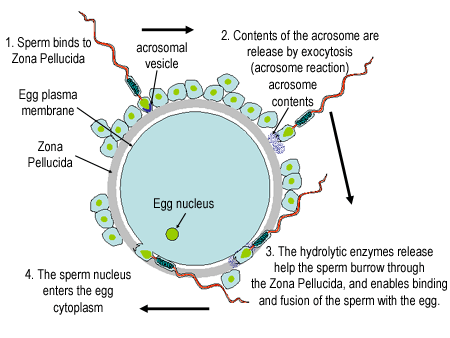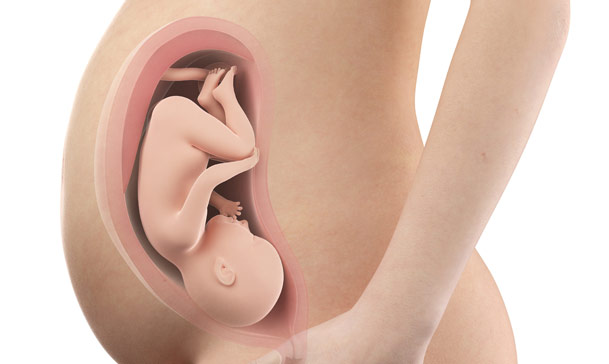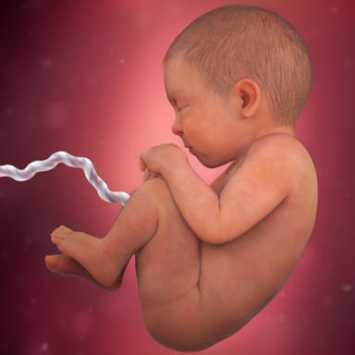What Happens During Forty Weeks Of Pregnancy
First of all I will start with the definition of pregnancy. Pregnancy: The state of carrying a developing embryo or fetus within the female body. This condition can be indicated by positive results on an over-the-counter urine test, and confirmed through a blood test, ...

Image of a pregnant woman
Here I will classify these forty weeks of pregnancy into three stages.....
The first stage (weeks 0_12)
Much of the hard work of growing a baby takes place during the first stage which is from conception until about twelve weeks. The egg is released from the ovary in the middle of the menstrual cycle(usually at around day fourteen for a regular cycle). The sperms swims towards the egg, and surround it in the outer part of one of the fallopian tubes. Onces one sparm has penetrated the egg, the egg's surface changes to prevent other sperms from getting through, and the fertilized egg journeys on down the tube and attaches itself to the lining of the uterus.
The woman may begin to notice slight changes, perhaps in her sense of taste, some breast tenderness, or feelings of nausea sometimes accompanied by throwing up. From week 5 to 8, the baby's main organs begin to grow and the nervous system develops. The heart begins to beat at about six weeks and the limbs start developing. The face also begins to develop and the mouth and tongue become visible. From this point, many women now notice they are pregnant. Their breasts may start to grow bigger, and they may feel tired and nauseous and go off certain foods. From week 9 to 12, the embryo begins to look more like a baby now and is technically referred to as a foetus. During this period, all the major organs such as the lungs, kidneys and liver are formed. The skeleton begins to develop too. The ears and nose can be recognized, and the eyes form, but are still closed. Fingers and toes are growing and the baby even has the beginning of external genital organs. You may discover that the feelings of nausea begin to reduce at this stage.

The second stage (weeks 13-28)
This is the most comfortable stage of pregnancy. Sickness and tiredness reduce extremely, your body begins to grow and becomes quite rounded. From week 13 to 18, the baby now looks like a baby, but is very tiny. All major organs begins to work including the kidneys. The baby makes breathing- like movements. This is not real breathing as the lungs will not expand and work until after he/she is born. His/her fingernails and toenails form, and eyebrows and eyelashes begin to grow. He moves around, and many mothers notice the first foetal movements at around eighteen weeks. The feeling is like butterflies or bubbles in the stomach. During week 19 to 24, the baby begins growing hair on his head. There is still more fluid than baby, and he/she can easily turn around inside the pregnant woman. The movements become more noticeable and your husband may be able to feel them if he places his hand on the bare skin of your stomach. By week 25 to 28, the pregnant mother can detect periods of rest and activity. Some babies seem to kick and move around at the same time each day, and they then have set times when they keep still, and possibly are asleep. His/her eyes open, and he/she may respond to the small amounts of light coming through the stretched abdominal muscles. He/she can suck his thumb, and may even get hiccups. This is a strange sensation for the mother, almost as if he were giving little regular kicks in the same place.

Image of a baby in his mother stomach at week 13-28
Reaching thirty weeks often feels like the last lap of a marathon. You may need to take your maternity leave from work at this stage, as you become bigger and need to rest more often. This though, varies from woman to woman. Some women are still full of energy, and quite happy working and keeping active. Others need to slow down, and begin to focus their attention on their baby. At week 29 to 32, the baby becomes well developed. He/she can swallow, hear, suck his/her thumb, recognize your voice, and if he/she were born now, would have a good chance of survival. However, the best place for him/her over the next few weeks is undoubtedly inside you, where he/she is safe, secure and continues to grow. You may notice that the baby's movements change as he get bigger. He/she has less room to move around now, but you may be able to identify which is a foot kicking and which is an elbow poking. At week 33 to 36, the baby continues to put on weight. He/she will probably settle into the head-down position and gradually move down. This happens at the lower part of the uterus softens for labour, and the baby fits into the top section of the pelvis. From week 37 to 40, the baby, who is now plump and strong is ready to be born. He/she will be able to breath and suck well from birth. He/she could arrive two weeks before or two weeks after your due dates, so it is important to plan what to do if you go overdue. You will probably find that you need to rest each day and conserve your energies for the hard work of labour.The third and final stage (weeks 29-40)

Image of a born child
Refrences: 1) Companion to obstetrics by christopher Huang and Victor Daniels.
- Everywoman by Derek Liewellyn Jones.
- Textbook for midwives by Margaret F. myles.
@godsgeneral it a very wonderfull experiense been through this got a beautiful baby girl
Congrat. Thanks @pricelessrita
Thanks
Good post, liked it.. :)
Thanks for ur vote I really appreciate @geetharao